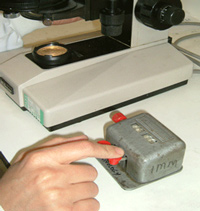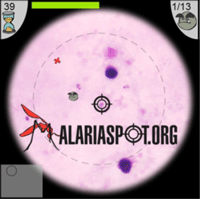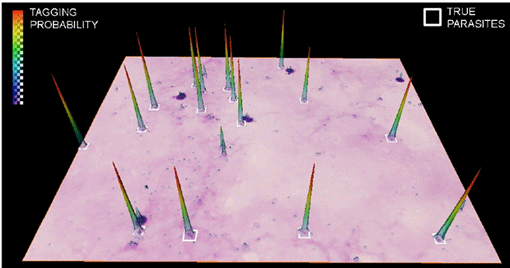
Campus Moncloa
Campus of International Excellence
Crowdsourcing clicks against malaria
Crowdsourcing techniques and on-line games allow tele-diagnosis of malaria images through the Internet, shows new study presented by researchers from the Technical University of Madrid.
03/12/2012

Manual counting of malaria parasites. Credits: Marcel Hommel (extracted from ―E-Module d’enseignement sur le paludisme‖)

MalariaSpot game. Credits: Luengo-Oroz
Malaria is one of the most important challenges for global health. It is responsible for nearly 1 million deaths and 200 million cases yearly. New research has proven the feasibility of a crowdsourcing system to tele-diagnose malaria images. The collective intelligence system relied on a community of on-line volunteers that learned to find and tag malaria parasites in digitized images of thick blood smears. This research has been recently published in a high impact journal of medical informatics (Journal of Medical Internet Research), and was directed by Dr. Miguel Luengo-Oroz from the Biomedical Image Technologies group at the Universidad Politécnica de Madrid within the framework of Moncloa Campus for the cluster of Innovation in Health, in collaboration with malaria expert John Frean from the Institute for Communicable Diseases in South Africa, and Spanish software developer Asier Arraz.
The standard diagnosis procedure for malaria consists of first assessing the presence and type of parasites, and then counting the number of parasites in blood smears using a microscope - a task which can take up to 20 minutes of time from a specialist, which may not always be available. The new study has replicated the parasite counting diagnostic phase using the on-line game Malariaspot - asking the crowd to diagnose and count the parasites instead of an individual expert. In the game, Internet players have to tag as many parasites as possible in 1 minute in digitalized real images of infected thick blood smears.
“The idea is that by combining the clicks from several non-expert volunteers that play the game, we are able to produce a unique parasite detection system with remarkably high accuracy.” explains Dr. Luengo-Oroz. “Each day, millions of hours are spent playing video-games, especially young people and digital natives. A small percentage of this time would be enough to diagnose all the malaria cases on the planet.”
Over the course of 1 month, anonymous players from 95 countries played more than 12,000 games and generated a database of more than 270,000 clicks on the test images. Data analysis revealed that the fusion of 22 games from players with no prior training or 13 players with a 1 minute training resulted in a perfect parasite count - as precise as an expert microscopist. In addition, the researchers have discovered a mathematical equation that allows the prediction of the parasite counting accuracy based on the number of volunteers and their training time. This equation could be used in the future to design new system implementations.
The research team is preparing for a next phase of investigation, which will consist of a real-time experiment at a rural clinic in an infected region, and is eager to expand the network of collaborators. Dr. Luengo-Oroz affirms “If the results continue to be positive, we can imagine a fast remote diagnosis system with the potential to scale globally. Digitalized blood samples would be distributed through the Internet - transforming mobile phones into low-cost microscopies.” The researchers expect to expand the applications of crowdsourcing techniques and artificial intelligence (that they have defined as “crowd-computing”) to other medical image diagnosis problems with massive image data and not enough specialists to analyze them.

Crowdsourced parasite detection. Players’ clicks on a malaria image have been grouped to create a parasite tagging probability map. Malaria parasites are signaled by white squares. Credits: Luengo-Oroz
Tag: i-Health Source: Universidad Politécnica de Madrid
Event date:
03/12/2012
